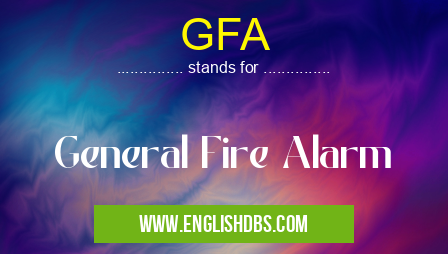What does GFA mean in FIRE DEPARTMENTS
GFA is an acronym commonly used in the governmental sector that stands for General Fire Alarm. A general fire alarm is a type of system that provides audible and visual alarms indicating the presence of smoke, heat, or other hazardous materials within a building. This system alerts personnel in the area to quickly evacuate or take proper precautions before more serious damage occurs. It is often mandated by local building codes and safety regulations to ensure the safety of all occupants. GFA systems are typically installed in large public buildings, industrial complexes, or any other areas where people could be at risk due to fire hazards.

GFA meaning in Fire Departments in Governmental
GFA mostly used in an acronym Fire Departments in Category Governmental that means General Fire Alarm
Shorthand: GFA,
Full Form: General Fire Alarm
For more information of "General Fire Alarm", see the section below.
Advantages Of GFA Systems
GFA systems offer numerous advantages when it comes to protecting individuals and property from fire related disasters. They provide early warning signals which alert personnel so they can act quickly if needed while also providing important information about the location of hazards enabling firefighters to better assess the danger they face should they enter a burning building. Furthermore, GFA systems are often mandated by local authorities making it mandatory for establishments to install them; this allows compliance with safety codes which helps reduce their liability if an incident occurs on their premises. Finally, these alarms are cost-effective solutions which offer long-term protection and peace of mind for those who use them as well as those who may be affected by potential disasters.
Essential Questions and Answers on General Fire Alarm in "GOVERNMENTAL»FIREDEPT"
What is a General Fire Alarm?
A general fire alarm (GFA) is a system designed to detect and alert building occupants of an impending fire risk. GFAs may include manual pull-stations, smoke detectors, heat detectors, sprinkler systems, and other components that are designed to quickly detect and respond to potential fire conditions.
How do GFAs work?
GFAs employ a combination of sensors such as heat and smoke detectors to detect the presence of a potential hazardous condition. If the GFA detects any one of these criteria, it will trigger an audible alert that will be audible throughout the building to notify all occupants. In some cases, it may also activate a sprinkler system or other suppression system.
Does a GFA require maintenance?
Yes. To ensure proper performance, GFAs should be tested and inspected regularly by qualified personnel. This should involve checking batteries, wiring connections, and any components for signs of wear or damage. Any malfunctions should be corrected immediately to prevent false alarms or unexpected shutdowns during emergencies.
Are special installation requirements needed for installing a GFA?
Yes; it is important that GFAs be installed in accordance with local codes and regulations. A qualified technician should carefully follow all instructions specific to each model when installing the GFA in order to ensure that it meets safety standards and works properly in the event of an emergency.
Should I choose wired or wireless technology for my GFA?
The type of technology used for your GFA largely depends on your specific needs. Wired systems provide more reliability but require more time for installation due to their need for wires running through walls, ceilings, floors etc., while wireless systems may offer easier installation but can lack connectivity in areas with large metal objects such as beams or pipes blocking transmission signals.
Do I need a separate power source for my GFA?
Depending on the type of system you have installed in your building, you may need an additional power source such as batteries if electricity fails in order to keep your system operational during emergencies.
How often should I test my GFA?
Testing frequency depends on local regulatory codes but generally tests should be performed at least once every 12 months by qualified personnel with appropriate training.
What happens if my GFA malfunctions during an emergency situation?
Malfunctioning GFAs can lead to false alarms or unexpected shutdowns which can put lives at risk during emergency situations. It is important that all components are checked regularly so that any signs of malfunction can be detected early on before they cause too much disruption.
What types of components make up a typical GFA system?
Typical GFAs include manual pull-stations, smoke detectors, heat detectors, sprinkler systems (or other suppression systems). Depending on the size and complexity of the facility more components such as sounders or horns may be included within some installations.
Final Words:
In conclusion, GFA stands for General Fire Alarm and is an important tool used in government sectors for providing early warnings about possible fires. These alarms are cost-effective solutions which help protect lives and property through the implementation of local authority mandates while also giving personnel vital information about potential threats if an emergency situation arises. By using this technology, organizations can better prepare themselves for what may come while ensuring compliance with laws as well as reducing liabilities should any disaster occur on their watch.
GFA also stands for: |
|
| All stands for GFA |
